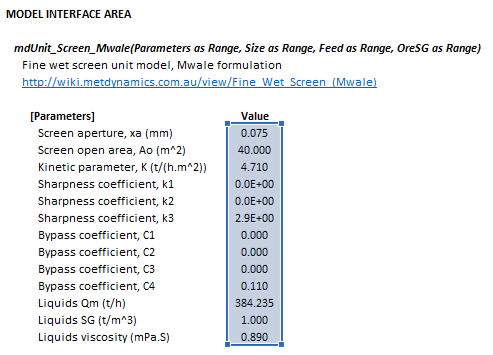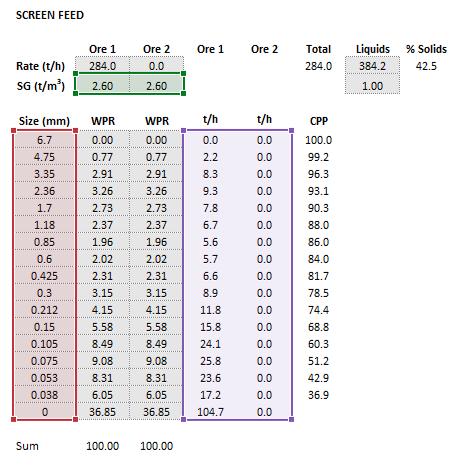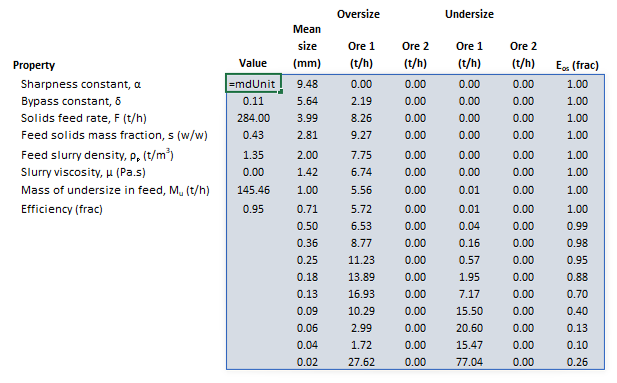Description
This article describes an implementation of the Mwale (Mwale et al., 2016) model for fine wet screening.[1]
Model theory
 This section is currently under construction. Please check back later for updates and revisions. This section is currently under construction. Please check back later for updates and revisions.
|
Excel
The Mwale fine wet screen model may be invoked from the Excel formula bar with the following function call:
=mdUnit_Screen_Mwale(Parameters as Range, Size as Range, Feed as Range)
Invoking the function with no arguments will print Help text associated with the model, including a link to this page.
Inputs
The required inputs are defined below in matrix notation with elements corresponding to cells in Excel row ( ) x column (
) x column ( ) format:
) format:

where:
 is the kinetic parameter (t/h.m2)
is the kinetic parameter (t/h.m2) is a bypass parameter ((t/h)-1)
is a bypass parameter ((t/h)-1) is the sharpness parameter (-)
is the sharpness parameter (-) is the screen open area (m2)
is the screen open area (m2) is the screen aperture (mm)
is the screen aperture (mm) is the mass fraction of solids in the feed slurry (w/w)
is the mass fraction of solids in the feed slurry (w/w) is the number of size intervals
is the number of size intervals is the size of the square mesh interval that feed mass is retained on (mm)
is the size of the square mesh interval that feed mass is retained on (mm) , i.e. descending size order from top size (
, i.e. descending size order from top size ( ) to sub mesh (
) to sub mesh ( mm)
mm) is the number of ore types
is the number of ore types is feed solids mass flow rate by size and ore type (t/h)
is feed solids mass flow rate by size and ore type (t/h)
Results
The results are displayed in Excel as an array corresponding to the matrix notation below:

where:
 is the efficiency of undersize removal achieved by the screen (frac)
is the efficiency of undersize removal achieved by the screen (frac) is the geometric mean size of particles in size interval
is the geometric mean size of particles in size interval  (mm)
(mm) is mass flow rate of solids to the oversize stream (t/h)
is mass flow rate of solids to the oversize stream (t/h) is mass flow rate of solids to the undersize stream (t/h)
is mass flow rate of solids to the undersize stream (t/h) is the partition to oversize (frac)
is the partition to oversize (frac)
Example
The images below show the selection of input arrays and output results in the Excel interface.
 Figure 1. Example showing the selection of the Parameters (blue frame) array in Excel. |
 Figure 2. Example showing the selection of the Size (red frame), and Feed (purple frame) arrays in Excel. |
 Figure 3. Example showing the outline of the Results (light blue frame) array in Excel. |
SysCAD
 This section is currently under construction. Please check back later for updates and revisions. This section is currently under construction. Please check back later for updates and revisions.
|
References
- ↑ Mwale, A.N., Mainza, A.N., Bepswa, P.A., Simukanga, S., Masinja, J.H., 2016. MODEL FOR FINE WET SCREENING. In XXVIII International Mineral Processing Congress Proceedings. Canadian Institute of Mining, Metallurgy and Petroleum.
























